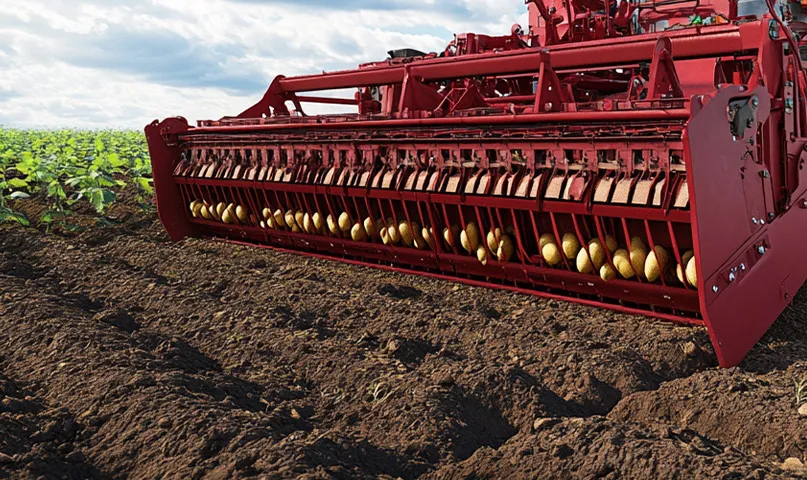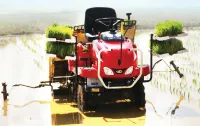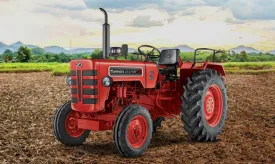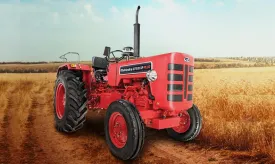How does a potato planter work and how does it improve productivity?

In the world of modern agriculture, efficiency is key to maximizing both yield and profit. For potato farmers, a potato planter is a vital tractor implement that can revolutionize the planting process. Traditionally, planting potatoes involved manual labor, which was not only labor-intensive but also time-consuming. With advancements in farming technology, the potato planter has emerged as a game-changer, making planting faster, more efficient, and highly productive.
How does a potato planter work?

A potato planter is a specialized machine designed to plant seed potatoes at precise depths and spacing. Here’s how it works:
- Seed potato loading: The machine is first loaded with seed potatoes. These are typically placed in a hopper at the top of the planter.
- Potato dispensing: The seed potatoes are then carefully dispensed onto the soil by the planter. The machine is designed to handle seed potatoes delicately to avoid damage to the tubers, which could negatively affect the germination process.
- Planting depth and spacing: The planter adjusts the planting depth and spacing of the potatoes based on pre-set specifications. The machine ensures that each seed potato is placed at an optimal depth for growth, typically around 4-6 inches, with uniform spacing to allow adequate room for the plant to grow. This precision is critical for maximizing yield.
- Soil covering: After the seed potatoes are placed in the soil, the machine covers them with soil to the correct depth. The planter has a set of discs or blades that create furrows, and after the potatoes are dispensed, the soil is gently returned to cover the seeds. This ensures that the potatoes are properly buried, which is essential for sprouting and early growth.
- Pressing and firming the soil: Many potato planters also come equipped with a pressing mechanism that firms the soil around the seed potatoes, ensuring good contact between the seed and the soil, which helps with proper root establishment.
How does it improve productivity?
Using a potato planter with a tractor improves farm productivity in several significant ways:
1. Time efficiency

Planting potatoes manually or using outdated methods is slow and labor-intensive. A potato planter can plant hundreds or even thousands of seed potatoes per hour, drastically reducing the time required to cover large fields. This increase in speed enables farmers to plant crops on time, which is critical for ensuring that potatoes grow during the optimal season.
2. Precision in planting

One of the standout features of a potato planter is its precision. The machine ensures that seed potatoes are planted at a consistent depth and spacing, which is crucial for uniform germination. This precision results in more even plant growth, which can increase overall yield and quality. Proper spacing also reduces the competition for nutrients and sunlight, leading to healthier plants and higher-quality potatoes.
3. Reduced labor costs

Manually planting potatoes requires significant labor, which can be both expensive and unsustainable, especially on larger farms. By automating the planting process with a potato planter, farmers can reduce their dependency on manual labor, which translates to lower labor costs. Fewer workers are required to plant large fields, and farmers can allocate labor to other important tasks, like irrigation or pest control.
4. Improved soil health

Potato planters often incorporate features that minimize soil disturbance, which is beneficial for the long-term health of the soil. Unlike traditional hand planting methods, which can cause excessive soil compaction, a potato planter ensures that the soil is cultivated gently, preserving its structure and organic matter. Healthy soil is essential for good root growth and higher crop yields.
5. Consistency and uniformity

Uniformity in planting is critical for ensuring consistent crop maturity. A potato planter guarantees that each seed potato is spaced evenly, which helps the plants mature at the same rate. This uniformity makes pest control, irrigation, and harvesting more efficient, ultimately leading to higher yields.
6. Reduced crop damage

Manual planting can sometimes result in damage to seed potatoes, especially if they are dropped or mishandled. Potato planters are designed to gently handle seed potatoes, reducing the risk of bruising or other forms of damage that could impair sprouting. Healthy seed potatoes are more likely to produce strong, productive plants.
7. Optimized resource use

By accurately planting potatoes at the right depth and spacing, a potato planter helps optimize the use of water, fertilizer, and other resources. This leads to more efficient farming practices, reducing waste and improving the sustainability of the farm. Farmers can also better manage their inputs for higher returns on investment.
Conclusion
A potato planter is a vital tractor implement that helps farmers plant potatoes more efficiently and effectively. By automating the planting process, it saves time, reduces labor costs, and ensures precise planting. The increased efficiency, uniformity, and reduced crop damage all lead to higher productivity, healthier crops, and better overall yield. Investing in a potato planter is not just a cost-effective decision—it’s a smart investment that will pay off in terms of higher profits, reduced labor, and better resource management for any potato farm.
















